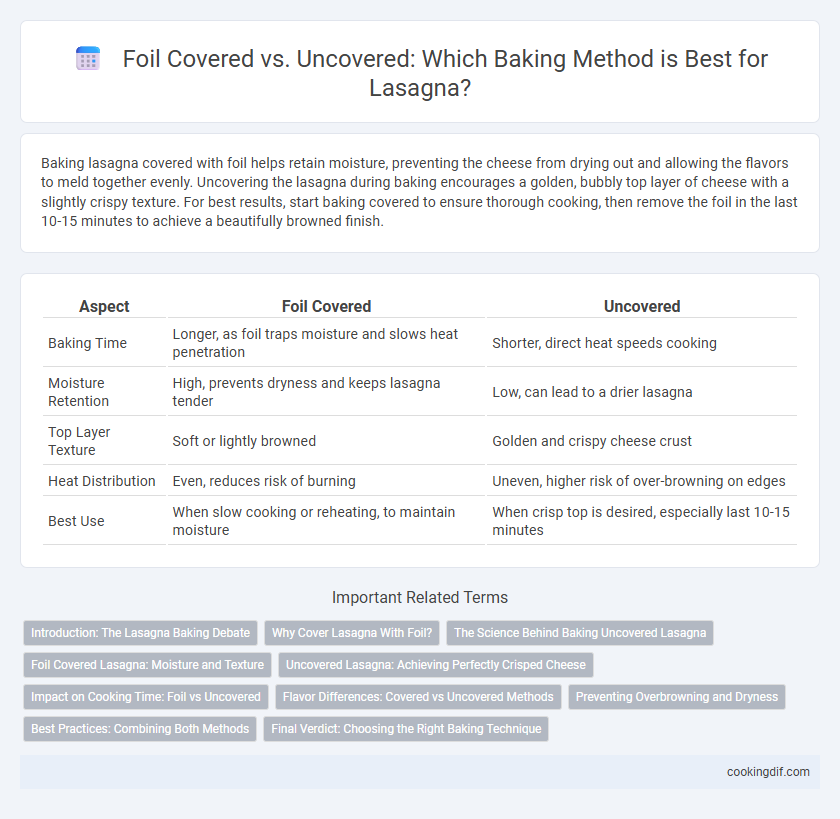Baking lasagna covered with foil helps retain moisture, preventing the cheese from drying out and allowing the flavors to meld together evenly. Uncovering the lasagna during baking encourages a golden, bubbly top layer of cheese with a slightly crispy texture. For best results, start baking covered to ensure thorough cooking, then remove the foil in the last 10-15 minutes to achieve a beautifully browned finish.
Table of Comparison
| Aspect | Foil Covered | Uncovered |
|---|---|---|
| Baking Time | Longer, as foil traps moisture and slows heat penetration | Shorter, direct heat speeds cooking |
| Moisture Retention | High, prevents dryness and keeps lasagna tender | Low, can lead to a drier lasagna |
| Top Layer Texture | Soft or lightly browned | Golden and crispy cheese crust |
| Heat Distribution | Even, reduces risk of burning | Uneven, higher risk of over-browning on edges |
| Best Use | When slow cooking or reheating, to maintain moisture | When crisp top is desired, especially last 10-15 minutes |
Introduction: The Lasagna Baking Debate
Covering lasagna with foil during baking traps steam, promoting even heat distribution and preventing the top layer from drying out or burning, which ensures moist and tender pasta sheets. Baking uncovered allows the cheese and sauce on top to brown and crisp, creating a desirable texture and rich flavor but risks overbrowning if not closely monitored. Optimal lasagna baking often involves starting covered and finishing uncovered to balance moisture retention and a golden, bubbly crust.
Why Cover Lasagna With Foil?
Covering lasagna with foil during baking helps retain moisture, preventing the top layers from drying out while allowing even heat distribution for thorough cooking. Foil traps steam, which softens noodles and melts cheese uniformly, resulting in a creamy texture. Baking uncovered can crisp the edges and brown the cheese but risks drying the dish if cooked too long without moisture retention.
The Science Behind Baking Uncovered Lasagna
Baking lasagna uncovered promotes better caramelization and Maillard reactions, resulting in a richer flavor and a crispier top layer compared to foil-covered methods. The absence of foil allows moisture to evaporate, concentrating flavors and enhancing texture by preventing sogginess. Heat transfer is more direct, improving browning and creating the signature golden crust coveted in traditional lasagna dishes.
Foil Covered Lasagna: Moisture and Texture
Foil-covered lasagna retains moisture effectively during baking, resulting in a tender and evenly cooked texture with less drying of the pasta layers. The foil traps steam, preventing the top from becoming overly browned or crusty, which preserves a soft, cohesive structure throughout. This method is ideal for achieving a moist interior while maintaining a balanced, rich flavor profile in the finished dish.
Uncovered Lasagna: Achieving Perfectly Crisped Cheese
Baking lasagna uncovered allows the cheese on top to melt evenly and develop a beautifully crisp, golden-brown crust that enhances flavor and texture. Leaving the dish uncovered promotes moisture evaporation, preventing sogginess and resulting in distinct, caramelized cheese edges. This method is ideal for achieving a visually appealing lasagna with a satisfying, crunchy cheese topping.
Impact on Cooking Time: Foil vs Uncovered
Covering lasagna with foil during baking significantly reduces cooking time by trapping steam, which helps cook the layers evenly while preventing the top from drying out. Uncovered lasagna requires a longer baking time to achieve a browned, crispy top, but it can cause the edges to dry prematurely. Using foil for most of the baking process, then uncovering in the last 10-15 minutes, balances a moist interior with a golden, bubbly crust.
Flavor Differences: Covered vs Uncovered Methods
Baking lasagna covered with foil traps moisture, resulting in a tender, evenly cooked dish with enhanced melding of flavors and a softer cheese texture. Uncovered baking promotes caramelization and browning on the top layer, creating a richer, slightly crisp crust with intensified roasted flavors. Choosing foil coverage influences the balance between creaminess and texture, directly impacting the final flavor profile of the lasagna.
Preventing Overbrowning and Dryness
Foil-covered lasagna retains moisture by trapping steam, preventing overbrowning and dryness during baking. Uncovered lasagna allows the top to brown and crisp, but requires careful timing to avoid excessive drying. Balancing baking time between covered and uncovered phases ensures a moist interior with a perfectly browned crust.
Best Practices: Combining Both Methods
Using foil-covered and uncovered baking methods in lasagna preparation ensures optimal moisture retention and a golden, bubbly top layer. Covering lasagna with foil during the initial baking phase prevents drying and allows even heat distribution, while uncovering it in the final 10-15 minutes promotes browning and cheese crispiness. This combined approach balances thorough cooking with an appealing texture, resulting in a perfectly baked lasagna.
Final Verdict: Choosing the Right Baking Technique
Using foil-covered baking for lasagna ensures even heat distribution and prevents the top layer from drying out, preserving moisture and enhancing flavor. Uncovered baking promotes a crispy, golden-brown cheese crust, adding texture and visual appeal to the dish. For optimal results, start covered to cook thoroughly and finish uncovered to achieve the perfect balance of tenderness and crispiness.
FOIL COVERED vs UNCOVERED for baking method Infographic

 cookingdif.com
cookingdif.com